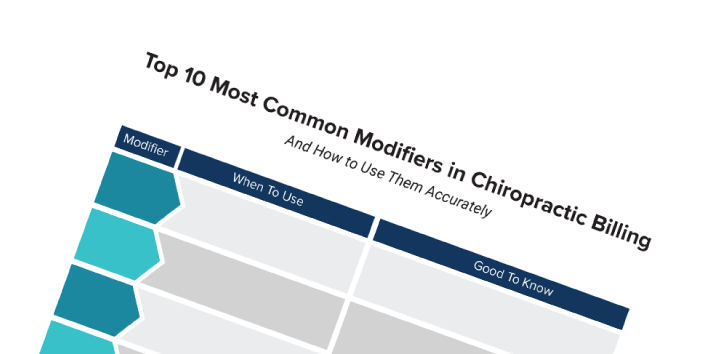The most common method of documentation used by chiropractors is the SOAP note, which is an acronym for Subjective, Objective, Assessment and Plan.
Not only are SOAP notes a necessity for successful practice management, they also benefit doctors, patients and office staff alike. For starters, SOAP notes:
- Allow providers to record and share information in a universal, systematic and easy-to-read format.
- Document a patient’s progress and determine the quality of care they receive.
- Ensure accuracy in coding and billing.
Are necessary for practical office management purposes.
But even seasoned providers who have been using SOAP notes for years might not fully understand just how important it is to document all the necessary information – especially for Medicare or in cases of litigation.
The Importance of SOAP Notes
The importance of having complete documentation within your SOAP notes can’t be overstated. For instance, they:
- Can be used to defend yourself against a malpractice suit.
- Can help prove that the plaintiff doesn’t have a case.
- Help keep you compliant, and in case of an audit, will prove you followed proper procedures.
- Justify your charges in a third-party payer audit.
- Are geared toward quality rather than quantity.
- Enable healthcare providers to easily understand patient records.
- Help chiropractors easily evaluate a patient’s progress over time.
- Provide the specificity that Medicare requires.
- Help chiropractors determine how to address a patient’s complaint by way of diagnosis and treatment.
- Should include essential details, such as the exact type of pain and location.
Chiropractic Coding Modifier Quiz
Put your coding skills to the test. Take our coding quiz to see how well you know your coding modifiers.
PLUS you’ll receive a our handout “Top 10 Most Common Modifiers in Chiropractic Billing”

The Four Main Sections
As previously mentioned, SOAP notes are comprised of four main sections: Subjective, Objective, Assessment and Plan. Here is the specific information you will need to include within each of these sections.
1. Subjective
This section should include whatever a chiropractic patient tells you about their complaint, as well as patient history and the review of intake forms. It’s subjective, because it conveys the patient’s experience of their condition, and typically includes things like neck pain, back pain, or other neuromuscular issues. Other areas to consider when describing a pain history for a new patient/complaint are:
- Mechanism of Injury. How the symptoms started. If the patient denies trauma, they should be questioned as to new activities and repetitive activities (work and home).
- Onset. Include the actual date of injury as day/month/year, not “last Tuesday.” If the patient cannot give a specific, then “insidious onset” should be recorded with an approximate time of initiation of symptoms such as days/weeks/months/years ago.
- Palliative/Provocative. What makes it better (palliative), and what makes it worse (provocative)? This might be things like icing, heat, bending, sleeping, moving in particular ways, etc.
- Quality. Include patient’s description of pain. For example: achey, crampy, nagging, throbbing, etc.
- Radiation or Referral. Radiating, or if not, “patient denies radiation or referral of symptoms,” or “symptoms remain local.”
- Severity. Severity of sx’s “0-4” scale “0-10” scale; pain diagram; visual analogue
- Scale Temporal Factors. Examples:
- Is chief complaint worse in the morning or evening?
- Is it constant or intermittent?
- Is it worse before or after specific activities?
- Is getting worse since onset?
- Associated with mealtimes, worse seasonally, or associated with menstrual cycle?
- Unrelated symptoms. Include associated symptoms, e.g. headaches or any other “unrelated” symptoms.
The first subjective note for a patient is generally much longer, as it contains the history elements. Subsequent subjective notes on follow-up visits should include any changes in symptoms or new symptoms, the current level of pain, how the pain has changed since the last patient visit, as well as an account of how the problem affects a patient’s daily activities and any functional improvements.
2. Objective
The Objective part of SOAP includes the chiropractor’s measurable findings and data of the patient, including:
- Neurological tests
- Orthopedic tests
- Inspections of area of chief complaint, posture, gait, habitus, etc.
- Palpation of soft tissues, subluxation/intersegmental dysfunction findings
- Imaging studies
- Outcomes assessments scores
3. Assessment The Assessment takes into account what the doctor learns from the patient’s information and the examination performed. It includes the diagnosis and prognosis, and may also involve a differential diagnosis. When the diagnosis is unclear, the doctor should include possible diagnoses listed in order of most to least probable. This component includes a chiropractor’s assessment of the patient’s progress.
The Assessment takes into account what the doctor learns from the patient’s information and the examination performed. It includes the diagnosis and prognosis, and may also involve a differential diagnosis. When the diagnosis is unclear, the doctor should include possible diagnoses listed in order of most to least probable. This component includes a chiropractor’s assessment of the patient’s progress.
Diagnosis. This is a conclusion as to what the patient’s condition is, as gleaned from reviewing both subjective and objective data. The patient’s response to treatment (current day and overall) can be stated here as well. In regards to diagnosis, a change in severity or stage should also be noted here. For example, a change from acute sprain/strain to sub-acute sprain/strain.
Prognosis. Note impediments to recovery, ADL limitations or changes, and short- and long-term clinical/patient goals. Important note: Medicare requires the primary diagnosis be the intersegmental dysfunction/subluxation diagnosis code (739.X) followed by a secondary code from a list of diagnoses approved by Medicare for chiropractors to treat.
4. Plan
The Plan should communicate what the chiropractor will do to address and treat the patient’s condition. This management plan can include things like:
- Lab work ordered
- Therapeutic treatment and exercises
- Expected duration and frequency of care
- Referrals needed
- Lifestyle modifications
- Nutritional advice
- Timeline for implementation
- Modalities
- Types of STM, CMT, modifications to ADLs
The chiropractor should note any adjustments or other services provided during each patient visit.
Are Your SOAP Notes Thorough?
There’s a good way to assess whether or not your SOAP notes are thorough. Ask yourself this question: if another chiropractor had to take over and continue treatment for your patient tomorrow, would they be able to do so quickly and easily just from reading the SOAP notes? If they are concise, clear and intelligible to a third party, the answer is yes!
Additional Resources
We know that as important as SOAP note documentation is, it can also feel laborious, time-consuming and monotonous. ACOM Health can offer you solutions that will help make SOAP notes easier while improving accuracy and giving you peace-of-mind in the case of an audit or lawsuit.
Our billing services and chiropractic EHR and practice management software software makes SOAP note documentation a breeze, and will increase practice efficiency. Let us show you how.
Transform Your Daily Operations
with Total Practice Performance from
$299/month
or call (866) 286-5315
(Software Included Free when you sign up for our Chiropractic Billing Service)

